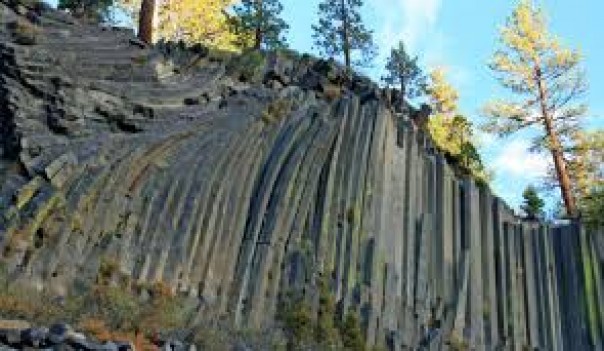This Day in History : The Baigong Pipes, a mysterious series of ancient pipe, found embedded in the rock near Mount Baigong in China
 The Baigong Pipes
The Baigong Pipes
News24xx.com - The Baigong Pipes, a mysterious series of ancient pipe-like features embedded in the rock near Mount Baigong near Delingha, China, were first reported in the Henan Great River News on June 16, 2002.
Located on the edge of the Qaidam Basin at the base of a range of Himalayan foothills lies Delingha, a town of raw beauty and the approximate site of the Baigong Pipes.
First discovered by a group of American scientists seeking dinosaur fossils in Delingha, the Baigong Pipes were found in a 50- to 60-metre-high pyramid-shaped outcropping on the south bank of a salt lake.
Read more: A tourist broke the toes of a famous sculpture that dates back to 1804 at Italy's Museo Antonio Canova 
At the front of the pyramid, they discovered three caves with triangular openings, the largest of which was six metres in depth (the two smaller caves are collapsed). Inside the largest cave is an astonishing feat of ancient engineering: a half-pipe about 40 centimetres in diameter extending from the top to the inner end of the cave, with another pipe plunging into the Earth. Like an ancient construction site, rusty scraps, pipes, and shaped stones are scattered about the site surrounding the cave.
Scientists have dubbed the Baigong Pipes “out of place artefacts,” or modern objects discovered in ancient settings. The ancient metal pipes appear to predate known history and are embedded into rock, precluding any theories that they were recent additions to the landscape. In another feat of sophisticated ancient engineering, the pipes lead through one of the nearby Himalayan foothills and connect to a salt lake.
Scientists tested the metal pipes and discovered that they are iron pipes smelted by ancient craftsmen some 140,000 to 150,000 years ago. Human history in the region only dates back some 30,000 years, posing a modern-day mystery for scientists.
Read more: Balinese Tradition to Ask for Prosperity
Some paranormal enthusiasts describe the pipes as an ambitious project developed and abandoned by extraterrestrial beings. Others say the seepage of iron-rich magma into existing rock fissures embedded the pipes in the rock. Still, others posit that ancient floods flushed iron-rich sediment into those same rock fissures.
Inspired by a similar case of ancient pipes found in Louisiana in the US, scientists now believe the pipes are fossilized casts of tree roots, formed by a chemical process in which soil is turned into rock through compaction and cementation. The result of the process is a series of metallic pipe-like structures that appear to be feats of ancient engineering. As for the landscape, the Qaidam basin was once a vast lake. Over the millennia, floods filled the basin with runoff, alluvium, and debris like these tree root fossils.
In the end, it was a modern feat of investigation, not an ancient feat of engineering, that determined how a series of sophisticated iron pipes, tens of thousands of years older than any people who may have forged them, got embedded in sandstone in barren stretches of China near the Himalayan foothills.
-
 Aug 06, 2020 | 05:15 pm LT
Aug 06, 2020 | 05:15 pm LTA tourist broke the toes of a famous sculpture tha...
-
 Oct 14, 2019 | 10:12 am LT
Oct 14, 2019 | 10:12 am LTBalinese Tradition to Ask for Prosperity...
-
 Oct 01, 2019 | 11:12 am LT
Oct 01, 2019 | 11:12 am LTGay Dancers Break Down the Cambodia Tradition ...
-
 Sep 30, 2019 | 10:04 am LT
Sep 30, 2019 | 10:04 am LTThousands of Visitors in America Amazed by the In...
-
 Sep 30, 2019 | 08:24 am LT
Sep 30, 2019 | 08:24 am LTA Javanese Meditation was being Developed by This ...
-
 Sep 26, 2019 | 01:51 pm LT
Sep 26, 2019 | 01:51 pm LT440 Women as Murder Victims' Shoes Turned into Art...

-
 Aug 16, 2020 | 05:06 am LT
Aug 16, 2020 | 05:06 am LTAttack of Racism; Give Salute in the style of Nazi...
-
 Aug 09, 2020 | 11:50 am LT
Aug 09, 2020 | 11:50 am LTViral Story of an old woman in Indramayu who almos...
-
 Aug 09, 2020 | 10:55 am LT
Aug 09, 2020 | 10:55 am LTMark Zuckerberg has joined the world's most exclus...
-
 Aug 09, 2020 | 10:45 am LT
Aug 09, 2020 | 10:45 am LTRevealed! It turns out that this is the origin of ...
-
 Aug 09, 2020 | 10:42 am LT
Aug 09, 2020 | 10:42 am LTSevere! A Woman in South Tangerang is Raped After ...
-
 Aug 09, 2020 | 09:34 am LT
Aug 09, 2020 | 09:34 am LTDor! This Man's Intestine Explodes After Eating A ...




